St. Mary’s Church is situated in High Street, Haverfordwest, and contains a War Memorial for the men of her Parish who fell in the Great War, as well as several individual memorials. Many of these men are on the main Haverfordwest War memorial which is sited in the County War Memorial Hospital at Withybush, but there are also several very interesting men who do not appear on the main memorial, but are included at St. Mary’s. For this reason, this memorial warrants a separate page. The memorial is made of teak, inlaid with bronze lettering, and was the gift of Lady Philipps of Picton Castle, the wife of Lord St. David’s, whose two nephews are commemorated on it.
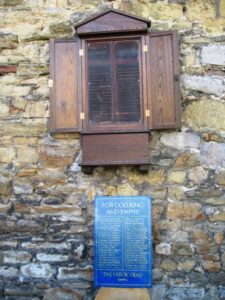
The Great War, 1914-1918
Alfred Arran, Private, 2001, Welsh Regiment. Alfred was the son of John and Mary Arran, of 41, Quay Street, Haverfordwest, and the Husband of Sarah Arran, of 5, Maeryerngran Cottages, Priory Street, Carmarthen. He was an old soldier, and had served in the Boer War, and re-enlisted at Haverfordwest into the 8th Battalion, Welsh Regiment, which was attached to 40 Brigade, 13th (Western) Division. Towards the end of February the entire Division concentrated at Blackdown in Hampshire. On 7 June 1915 orders were received to prepare to move to the Mediterranean, and on 13 June 1915 the first transports carrying the Division left port, and moved to Alexandria. By 4 July, all units had moved to Mudros, preparatory for landing on Gallipoli. Between 6 and 16 July 1915 the Divisional infantry landed on Cape Helles and relieved the 29th Division. It left and returned to Mudros at the end of the month, and the entire Division landed at ANZAC Cove between 3 and 5 August 1915, taking part in the Battle of Sari Bair. Alfred was killed in action here on 8 August 1915. He was 36 years old. Alfred has no known grave, and so is commemorated on the Helles Memorial, Gallipoli.
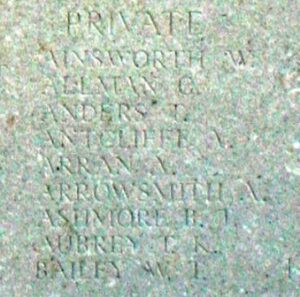
George Alfred Baillieux, Private, 389, Welsh Regiment. George was the son of Lambert Francis and Eliza Anne Baillieux, of 3, St. Mary’s Street, Haverfordwest. He enlisted at Haverfordwest into the 1/4th Battalion, Welsh Regiment. The Battalion was formed in Carmarthen in August 1914 and joined 159 Brigade, 53rd (Welsh) Division, and moved to the Mediterranean, sailing from Devonport in July 1915 and arriving at Mudros by 5 August 1915. From here they moved to Gallipoli, landing on 9 August, where it was plunged into a desperate assault, and spent the next few days in isolated pockets, fighting against a Turkish counter-attack. The Division remained here throughout the coming months, and suffered severe losses here. George was taken ill with typhus while on Gallipoli, and evacuated by Hospital Ship to the Military Hospital at Lemnos, where he sadly died on 29 September 1915. He was just 18 years old, and is buried in Portianos Military Cemetery, Lemnos, Greece.
Robert Frederick Bishop, Private, 17141, Coldstream Guards. Robert was the son of John Henry and Emma Bishop, of Dew Street, Haverfordwest. He enlisted there into the 1st Battalion, Coldstream Guards, which was stationed at Aldershot at the outbreak of war, attached to the 1st (Guards) Brigade, 1st Division. In August 1914 the Battalion moved to France, and saw their first action at the Battle of Mons, and the retreat to the Marne, where the Germans were stopped. They then fought at the Aisne, and at Chivy, before being moved north to Ypres. Here they fought at the First Battle of Ypres, where they again stopped the German Offensive, before wintering in Flanders. The following year saw them in action again at the Battle of Aubers, before moving South to Loos, where they joined the 2nd Guards Brigade, Guards Division, on 25 August 1915. It remained on the Western Front throughout the war and saw its first major action during the Battle of Loos on 25 September 1915, remaining in the area during the coming months, where they also fought in the subsequent Action of Hohenzollern Redoubt. In July 1916 the Division moved to the Somme, where it fought at the Battle of Flers-Courcelette, and then at the Battle of Morval, capturing Lesboeufs Village. Robert was killed in action here on 29 September 1916. He was 26 years old, and is buried in Guard’s Cemetery, Lesboeufs, France.
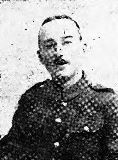
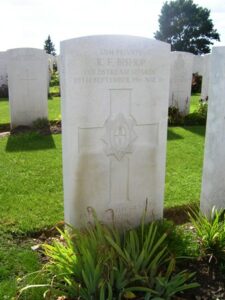
Harry Hickman Bromfield, DSO, Major, Welsh Guards. Harry was the son of Henry and Mary Elizabeth Bromfield, of Straford-on-Avon. He married Ethel Philippa Philipps in 1906, the eldest daughter of Sir Charles and Lady Philipps of Picton Castle. Harry had served in the South African War as Captain in the South Wales Borderers, and had gained the Distinguished Service Order in South Africa for his gallant leadership. He had become Chief Constable of Breconshire Constabulary prior to the war and volunteered to serve with the newly formed Welsh Guards in 1915, joining the battalion at Esher. The 1st Battalion, Welsh Guards was attached to 3rd Guards Brigade, Guards Division, which had been formed in France in August 1915. The various Guards units that had been with other Divisions were withdrawn to be brought together to create this fine formation. It remained on the Western Front throughout the war and saw its first major action during the Battle of Loos on 25 September, 1915, remaining in the area during the coming months, where they also fought in the subsequent Action of Hohenzollern Redoubt. In July, 1916 the Division moved to the Somme, and Harry joined it here, when he took command of Prince of Wales Company from Viscount Clive, who had been promoted. On 14 August the battalion was relieved by the 2nd Battalion Scots Guards, and went into a variety of rest-huts, ruins, and trenches round Colincamps. The Guards then moved back into the line, taking over from 48 Brigade a line along the outskirts of the wood at the end of Ginchy. The situation at the time was a mess. The Welsh Guards were facing the wrong way, as they did not know what had happened during the previous attack, and in the ensuing fighting, Harry was killed while leading his men gallantly on 10 September 1916, aged 47. He is commemorated on the Thiepval Memorial, France.
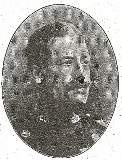
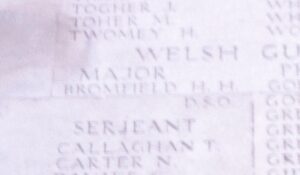
Benjamin James Charles, Private, 86460, Kings Liverpool Regiment. Benjamin was the son of John and Elizabeth Charles, of 79, Dew Street, Haverfordwest. He had enlisted at Haverfordwest into the South Wales Borderers, but had later transferred into the 6th Battalion, Kings Liverpool Regiment, which was attached to 165 Brigade, 55th (West Lancashire) Division. The division relieved the 42nd (East Lancashire) Division in the front line at Givenchy and Festubert on 15 February 1918, and faced numerous strong enemy raids in March. April was at first much quieter, but it was a lull before the storm, as the Germans launched another offensive here, with the Division taking part in the Battle of Estaires, successfully fighting at the First Defence of Givenchy, the single most famous action that the Division fought. Benjamin was wounded during the Battle of Estaires, and died on 29 April 1918 as a result. He was just 18 years old, and is buried at Pernes British Cemetery, France.
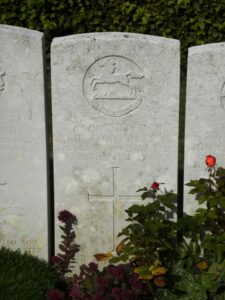
Austin Pugh Cook, Lieutenant, Royal Marine Light Infantry. Austin was born in 1893, the son of Charles Pugh and Mary Ann Cook, of 21, Bridge Street, Haverfordwest. After gaining his B.A. at Lampeter College, Austin was commissioned into the Royal Marine Light Infantry, and was posted to their 2nd Royal Marine Battalion. The Battalion was attached to the Royal Naval Division, and had fought at Antwerp, before moving to Gallipoli, where it gained a high reputation for its fighting ability. After the evacuation from Gallipoli, it moved to the Western front, in time to take part in the latter stages of the Somme Offensive, at the Battle of the Ancre. In April 1917 the Division were at Arras, and fought at the Second Battle of the Scarpe, where they captured Gavrelle. They then fought at the Battle of Arleux, and it was while the R.N.D. were still at Arras that Austin was killed on 26 July 1917. He was 23 years old, and is buried in Naval Trench Cemetery, Gavrelle, France.
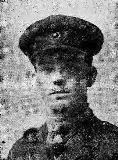
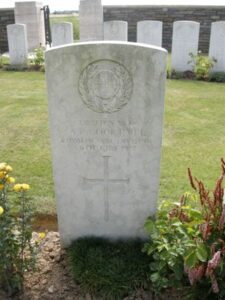
David Francis Davies, 200028, Company Quartermaster Sergeant, Welsh Regiment. David was the son of John and Margaret Anne Davies, of James’s Terrace, St. Dogmaels. He worked and lived in Haverfordwest just prior to the outbreak of war, and was part of the Territorial Army. When War was declared in August 1914, the Territorial’s were called up, and David joined up with his Battalion, the 4th Welsh, at Carmarthen, with the Battalion forming part of the South Wales Brigade. On 17 April 1915 the Battalion was attached to 159 Brigade, 53rd (Welsh) Division, and in July that year sailed with the Division to Alexandria, en route to Gallipoli. On 9 August 1915 the Division landed on Gallipoli, where they stayed until the middle of December, when after suffering severe losses, they were withdrawn to Egypt. In Egypt the Division guarded the Suez Canal, but were soon to move towards Palestine, successfully pushing back the armies of the Turkish Empire, who had defeated them at Gallipoli. In spring 1917 the Division attacked Gaza, and it was on the opening day of the Battle of Gaza that David was killed in action on 26 March 1917, aged 25. He has no known grave, and so is commemorated on the Jerusalem Memorial.
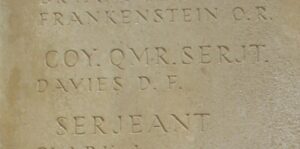
William Davies, Private, 46421, Welsh Regiment. William was the son of Daniel and Dinah Davies, of Carnhedryn Isaf, Solva. Prior to the war he resided with his wife, Annie Davies, at 40, Dew Street, Haverfordwest. He enlisted at Haverfordwest into the 9th Battalion, Welsh Regiment, which moved to France in July 1915 as part of 58 Brigade, 19th (Western) Division. The Division fought during the opening attack of the Battle of Loos, and then moved to the Somme, where they took part in the second wave of the attack on Ovillers-La Boiselle on 1 July, capturing the village at heavy cost, and fought through the Somme Battles of Pozières and the Ancre in 1916. They then moved north to Ypres, taking part in the Battle of Messines, and it was here that William was wounded. He was evacuated to 53 Casualty Clearing Station at Bailleul for treatment, but sadly died there of his wounds on 8 June 1917. William was 36 years old, and is buried in Bailleul Communal Cemetery Extension, France.
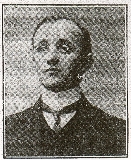
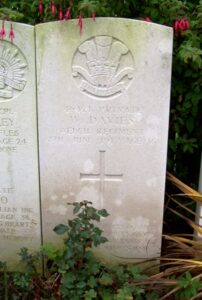
Charles John Randle Dawkins, Second Lieutenant, Welsh Regiment. Charles was the only son of Thomas and Clara Randle Dawkins, of Redhill, Haverfordwest. He was educated at Haverfordwest Grammar School and at Clifton College, and was a B.A. and LL.B. of Cambridge, having taken a First in Law and a second in the Historical Tripos. Charles was commissioned into the Welsh Regiment at the outbreak of war, and was posted to the 9th Battalion, which was attached to 58 Brigade, 19th (Western) Division. The Division assembled around Bulford during September 1914. Divisional training was completed near Tidworth, from March 1915, and the Division crossed to France during July 1915, moving to positions near Loos. The Division fought during the opening attack of the Battle of Loos, which is where Charles was killed in action, during the initial attack of 25 September 1915. He is 24 years old, and is buried in Brown’s Road Military Cemetery, Festubert, France.
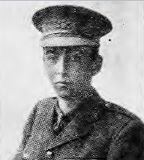
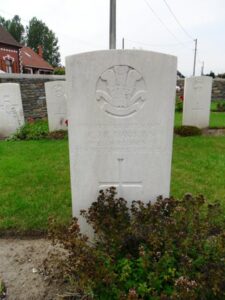
Walter Gordon Douglas-Willan, Major, Durham Light Infantry. Walter was the son of John Gordon Douglas-Willan, and the grandson of Colonel Douglas-Willan of Haverfordwest, who had fought with Lord Chelmsford during the Zulu War. He was commissioned into the 4th Battalion, Durham Light Infantry, but was then attached to the 22nd Battalion, which was the Pioneer Battalion to the 8th Division. The 8th Division was formed during October 1914, by the bringing together of regular army units from various points around the British Empire. The Division moved to the Western Front in November 1914, a badly-needed reinforcement to the BEF which had been all but wiped out at Ypres. They saw their first major action at the Battle of Neuve Chapelle, and then at the Battle of Aubers. They then saw further fighting at the Action of Bois Grenier, before moving to the Somme in 1916, where they fought at the Battle of Albert. In March, 1917 they followed the German Retreat to the Hindenburg Line, and later that year moved to Ypres, fighting at the Battle of Pilckem, and the Battle of Langemarck. In March, 1918 the Division were on the southern end of the Somme, and here met the German Offensive head on, at the Battle of St Quentin. Walter was killed here on 24 March 1918, aged 34. He has no known grave, and is commemorated on the Pozières Memorial, France.
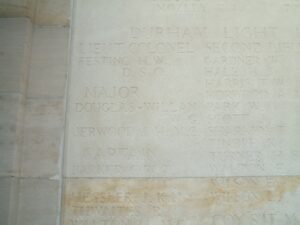
Gerald Alexander Dutton, Second Lieutenant, South Staffordshire Regiment. Gerald was the son of Samuel and Alice Dutton, Merlins Hill, and was educated at Haverfordwest Grammar School. He was commissioned into the South Staffordshire Regiment, and was posted to the 4th Battalion, which was a Home Service unit, stationed at Jersey until 1916. Sadly Gerald was accidentally killed by a bomb explosion during training on Jersey, on 5 May 1916, aged just 18. He is buried in St. Peter Churchyard, Jersey.
George Frederick Gibbon, Private, G/18198, Queen’s Own Royal West Kent Regiment. George was the son of Willie and Martha Gibbon of 2, Horns Lane Haverfordwest. He had enlisted on 15 November 1915 into the Royal Fusiliers, with the Regimental Number PS/9328, and served in France from 29 August 1916 until being wounded and returning home just over a month later. On 12 September 1917 he returned to France, and was posted to the 7th Battalion, Queens Own Royal West Kent Regiment. The Battalion was attached to 53 Brigade, 18th (Eastern) Division, and had been in France since 25 May 1915. George joined the battalion at Ypres, where they took part in the Battle of Pilckem, taking part in the capture of Westhoek. The division then fought at the Battle of Langemarck, and at the First Battle of Passchendaele, followed by the Second Battle of Passchendaele. In 1918 the Division were stationed south of the Somme, and were one of the Divisions hit there by the German Spring Offensive, which was launched on 21 March 1918. They fought at the Battle of St Quentin, and suffered terrible casualties, and then took part in the Battle of the Avre and the Actions of Villers-Bretonneux. George became ill and died in the field hospital at Cagny on 5 May 1918, aged 23. He is buried in Grand-Seraucourt British Cemetery, France.
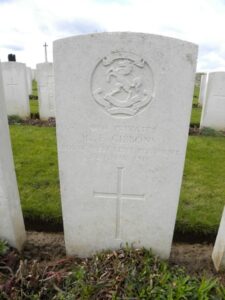
Archie Griffiths, Private, G/5868, Royal Sussex Regiment. Archie was the son of William and Maria Griffiths, of 44, Dew Street, Haverfordwest. He enlisted in September 1914 into the 2nd Battalion, Royal Sussex Regiment, which was attached to 2 Brigade, 1st Division. The Division had been one of the first to arrive in France, fighting at the Battle of Mons, and taking part in the retreat to the Marne, where the Germans were stopped. They then fought at the Aisne, and at Chivy, before being moved north to Ypres. Here they fought at the First Battle of Ypres, where they again stopped the German Offensive, before wintering in Flanders. The following year saw them in action again at the Battle of Aubers, before moving South to Loos, where they fought during the Battle of Loos, and the action at the Hohenzollern Redoubt. Archie was killed in action whilst the Division was near Arras, on 30 June 1916, just prior to their move to the Somme. He was just 20 years old, and is commemorated on the Arras Memorial, France. His brother Walter James Griffiths also fell.
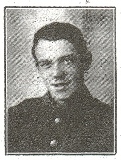
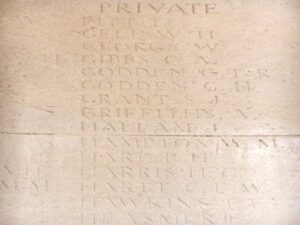
Ivor Griffiths, Private, 445, Welsh Regiment. Ivor was born at St. Davids, the son of Thomas and Elizabeth Griffiths. The family later resided at 6, North Gate, Haverfordwest. Ivor enlisted at Haverfordwest into the 1/4th Battalion, Welsh Regiment. The Battalion was formed at Carmarthen during August 1914 and was attached to 159 Brigade, 53rd (Welsh) Division. The 53rd Division moved to the Mediterranean, sailing from Devonport in July 1915 arriving at Mudros by 5 August 1915. From here they moved to Gallipoli, landing on 8 August. Here they immediately faced the chaotic leadership that was to lead to the ultimate failure of the campaign, and spent the next few days in isolated pockets, and fought at the Battle of Sari Bair, where Ivor was wounded. He was evacuated from Gallipoli, and brought to Gibraltar for treatment, but sadly died at sea of his wounds on 4 September 1915, aged 19. Ivor was buried ashore, at Gibraltar (North Front) Cemetery. His brother Frederick also fell.
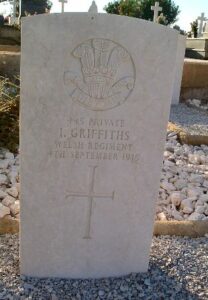
Walter James Griffiths, Lance Corporal, 302, Welsh Regiment. Walter was the son of William and Maria Griffiths, of 44, Dew Street, Haverfordwest. He enlisted at Bridgend into the 1/4th Battalion, Welsh Regiment, which was formed at Carmarthen during August 1914 and was attached to 159 Brigade, 53rd (Welsh) Division. The 53rd Division moved to the Mediterranean, sailing from Devonport in July 1915 arriving at Mudros by 5 August 1915. From here they moved to Gallipoli, landing on 8 August. Here they immediately faced the chaotic leadership that was to lead to the ultimate failure of the campaign, and spent the next few days in isolated pockets, and fought at the Battle of Sari Bair, where Walter was one of many men of the Battalion killed on 10 August 1915. He was just 21 years old, and is commemorated on the Helles Memorial, Gallipoli. His brother Archie also fell.
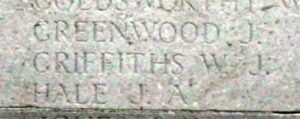
Alfred Heywood Howard, Captain, Welsh Regiment. Alfred was born at Heaton, Lanashire in 1869, the son of Joseph and Fanny Howard. He was a Bank Manager prior to the war, and resided at Bank House, Haverfordwest with his wife Elizabeth and their daughter Vera. Alfred was commissioned into the Welsh Regiment, and was attached to the 4th Battalion at the outbreak of war. The Battalion was the Carmarthenshire Territorial Battalion, and was formed at Carmarthen on 4 August 1914, attached to South Wales Brigade, Army Troops. In November 1914 the Brigade moved to Tunbridge Wells, and then in February 1915 to Scotland on Forth and Tay Defences. On 17 April 1915 the Battalion was posted to 159 Brigade, 53rd Division at Bedford, and on 19 July 1915 sailed from Devonport for Mudros, arriving on 5 August. From here the Division moved to Gallipoli, and on 8 August 1915 landed at Suvla Bay. Here they immediately faced the chaotic leadership that was to lead to the ultimate failure of the campaign, and spent the next few days in isolated pockets, fighting against a Turkish counter-attack during the Battle of Sari Bair, which is where Alfred was killed on 10 August 1915, aged 45. Alfred has no known grave, and is commemorated on the Helles Memorial, Gallipoli.
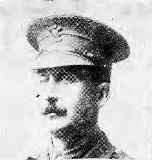
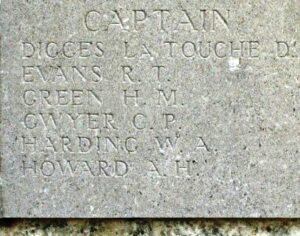
David Alfred Hughes, Private, 44743, Royal Welsh Fusiliers. David was the youngest son of James and Ann Hughes, of 75, Dew Street, Haverfordwest. He enlisted at Haverfordwest on 1 March 1916 into the Welsh Regiment, and was posted to Kinmel Park, Rhyl, for training. Here David joined the 18th Battalion, Royal Welsh Fusiliers on 18 April, which was a Reserve Battalion. David’s service was not to last long however. He became ill weeks after arriving at Rhyl, and was hospitalised there, dying of cardiac asthma and cirrhosis of the liver on 7 May 1916. He was 29 years old, and was brought home to be buried in St. Mary’s Church Cemetery, Haverfordwest.
Charles Jenkins, Second Lieutenant, Royal Flying Corps. Charles was born on 2 January 1897, the second son of John Lewis and Bessie Jenkins, of Cleddau Lodge, Haverfordwest. Educated at Haverfordwest Grammar School, Charles then attended the London Wireless College, and from there he enlisted into the Signal Section of the Royal Engineers on 11 November 1914. Charles served on the Western Front from January 1916 and returned to England in July 1917 to train at Winchester and Oxford. In November 1917 Charles was gazetted 2nd Lieutenant in the Royal Flying Corps, and gained his Wings in January 1918. Charles was sadly killed whilst flying at Upavon, Wiltshire on 21 March 1918. He was buried days later at St. Mary’s Church Cemetery, Haverfordwest. His Commanding Officer wrote in a letter to John and Bessie; ‘Your son was a fine and fearless Pilot, very popular, and we feel his loss keenly’.
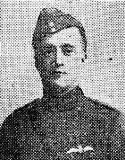
Charles William John, Private, 33248, Welsh Regiment. Charles was the son of Thomas and Annie John, of 21, Quay Street, Haverfordwest. He enlisted there into the Welsh Regiment and was posted with the 10th Battalion, Welsh Regiment, which was attached to 114 Brigade, 38th (Welsh) Division. The Division had landed in France during December 1915 and had spent its first winter in the trenches near Armentieres. In June the division marched south to the Somme, where it was tasked with the capture of Mametz Wood. The first attack on the wood went in on 7 July 1916, by 115 Brigade, but the men were mown down by machine-gun fire. Blame was put on the Divisional Commander, who returned home, and a fresh assault was planned under a new commander for 10 July 1916. Charles was killed during the assault on the wood on 10 July 1916, aged 23. He is buried in Carnoy Military Cemetery, France.
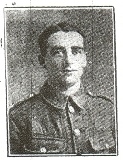
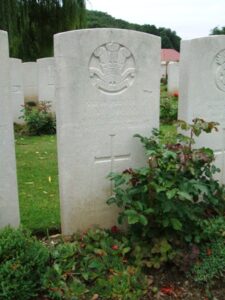
Valley John, Private, 91138, Machine Gun Corps. Valley was the son of Elizabeth John, of 18, Quay Street, Haverfordwest. He worked as a railway platelayer prior to the war, based at the GWR depot at Llanelli. Valley had married Maria Williams at Haverfordwest in 1912. He enlisted at Llanelli into the Machine Gun Corps, and was posted to the 30th Battalion, which was attached to the 30th Division. The Division moved to France in November 1915, and took part in its first major action during the Somme Offensive, at the Battle of Albert, where they captured Montauban. They then fought during the latter stages of the offensive, during the Battle of Le Transloy, before wintering on the Somme. In March 1917 the Division followed the German Retreat to the Hindenburg Line, and in April took part in the First Battle of the Scarpe, and then at the later Second Battle of the Scarpe. Later that year they were moved north to Ypres, and fought at the Battle of Pilckem. At the beginning of 1918 the Division were stationed near St. Quentin, and when the Germans launched their Offensive here on 21 March, the Division took part in the Battle of St Quentin, which is where Valley was wounded. He died of his wounds on 31 March 1918, aged 27. Valley is buried in Chambieres French National Cemetery, France.
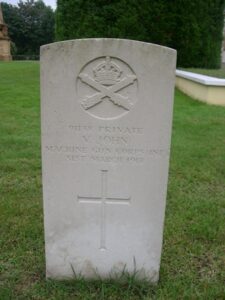
George Frederick Jones, Private, 1140, Welsh Guards. George was the eldest son of Henry and Mary Jane Jones, of Haverfordwest. He enlisted at Llanelli into the 1st Battalion, Welsh Guards. The Regiment was raised by Royal Warrant of 26 February 1915, at White City, before landing at Le Havre on 18 August 1915, becoming attached to 3rd Guards Brigade, Guards Division. The Division saw its first major action during the Battle of Loos on 25 September 1915, remaining in the area during the coming months, where they also fought in the subsequent Action of Hohenzollern Redoubt. After a brief rest period, the Division moved for Ypres for a short spell in what was, at that time, a quiet sector. George was killed in action at Ypres on 29 April 1916, aged 23. He is buried in Potijze Burial Ground Cemetery, Belgium.
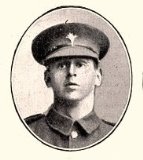
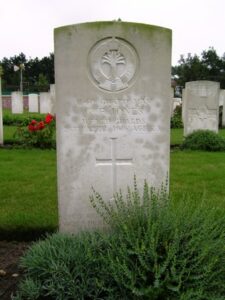
Thomas Evan Jones, Sergeant, 200005, Welsh Regiment. Thomas was born in 1886, the son of James and Ellen Jones, of New Street, Haverfordwest. He was a coach builder prior to the war, and resided with his wife Kate Jones and their children at 82, Dew Street, Haverfordwest. Thomas served with the 1/4th Battalion, Welsh Regiment. The Battalion had served at Gallipoli during 1915 attached to 159 Brigade, 53rd (Welsh) Division, and by 23 December 1915 were moved to Egypt. They remained on the Suez Canal Defences for the next twelve months, and in early 1917 moved into Palestine, where they remained for the duration of the war, fighting at the Battles of Gaza, and successfully capturing Jerusalem. Thomas was killed in action during the First Battle of Gaza, on 26 March 1917, aged 30. He has no known grave, and is commemorated on the Jerusalem Memorial, Israel.
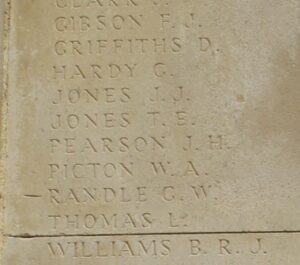
Ivor Norman Jones-Parry, Lieutenant, Royal Garrison Artillery. Ivor was the son of Thomas and Selina Alfreda Jones-Parry, of 5, Hillcrest Rd., Acton, London. His parents were formerly of Bank House, Amlwch, Anglesey, and the National Provincial Bank, Haverfordwest, Pembrokeshire. Ivor was educated at Llandovery College from 1906 until 1909, and at the outbreak of war he was a Second Lieutenant in No. 2 Company, Pembrokeshire Territorial’s. He was commissioned into the Royal Garrison Artillery on 12 August 1915, and moved to France late in 1916, serving with the 171st Siege Battery. Ivor was killed in action during the Battle of Arras, on 12 May 1917. He was 24 years old, and is buried in Mory Abbey Military Cemetery, France.
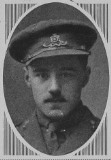
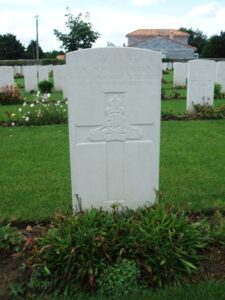
Stuart Leslie Keppel-Palmer, MC, Captain, Tank Corps. Stuart was born in 1894, the fourth son of Llewellin and Eveline Keppel-Palmer, of Haverfordwest and Geneva, and the brother of Mr. H.G. Keppel-Palmer and Mr. C.M. Keppel-Palmer, of Johnston Hall. He was educated at Bromsgrove and Winchester, and after unsuccessfully applying to join the Royal Navy, became a Pupil at the Lancaster and Yorkshire Locomotive Works at Horwich. He enlisted into the Royal Engineers in August, 1914 and was commissioned in October that year. Stuart was transferred into the Tank Corps at its formation in 1916, and joined the 3rd Light Battalion. After surviving the inaugural use of the tank on the Somme in 1916, and the abortive attempt to use tanks in the sodden battlefields of Passchendaele in 1917, Stuart was wounded at their next major offensive at the Battle of Cambrai, but gained the award of the Military Cross for his actions. The London Gazette of 8 January 1918 published his citation, which read; “For conspicuous gallantry and devotion to duty. As Section Commander he led his section with the greatest gallantry, and when his flag tank was out of action he joined another one until it became ditched. Being unable to get it into action again in spite of most strenuous exertions, he joined a third tank, which he directed with complete success, having on all of these occasions to pass fully exposed over many hundred yards of bullet-swept ground.” Sadly, Stuart was killed within weeks of the end of the war, on 3 October 1918, when his tank was hit twice by German shells. He was 24 years old, and is buried in Prospect Hill Cemetery, Gouy, France.

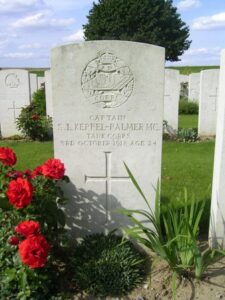
P. Lewis, Royal Welsh Fusiliers. Cannot be identified. There were two P. Lewis that were killed while serving with the RWF in the Great War, and both were from North Wales.
Charles Henry Morgan, Private, 126129, Machine Gun Corps. Charles was the son of Thomas Henry and Janet Morgan, of 34, Dew Street, Haverfordwest. He enlisted there into the Welsh Regiment, with the Regimental Number 203538, and after training as a Lewis Gun Specialist, was transferred into the 38th Battalion, Machine Gun Corps, attached to the 38th (Welsh) Division. The Division had landed in France during December 1915 and had spent their first winter in the trenches near Armentieres. In June they marched south to the Somme, where they were tasked with the capture of Mametz Wood. The attack on the wood began on 7 July, but met with fierce resistance, and it took until 14 July to clear the wood. The Division suffered terrible casualties at Mametz, and were taken out of the line, and moved to Ypres to rebuild. Here they fought at the Battle of Pilckem Ridge, and the Battle of Langemarck. They then moved to Armentieres, where they remained from September 1917 until March, 1918 when the German Spring Offensive was launched. The British had been over-run on the Somme, and so in April the Division was moved south, taking up positions North of Albert, from where they weathered the storm of the coming months, until the war turned during the Battle of Amiens, on 8 August, 1918. The Germans had now lost the upper hand, and the British regained the lost ground on the Somme after an attack which began on 21 August, with the 38th Welsh in the midst of the attack during the Battle of Albert, and then moving east, where they fought at the Battle of Bapaume. Charles was wounded during the Battle of Albert, and died on 24 August 1918. He is buried in Daours Communal Cemetery Extension, France. His brother Frederick was killed at Gallipoli in November 1915.
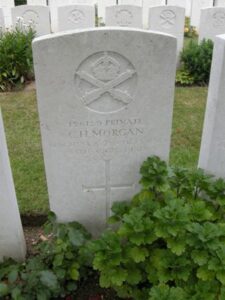
Frederick Morgan, Private, 390, Welsh Regiment. Frederick was the son of Thomas Henry and Janet Morgan, of 34, Dew Street, Haverfordwest. Frederick was one of the many young men of Haverfordwest who joined the local Battalion, the 1/4th Battalion, Welsh Regiment, which was attached to 159 Brigade, 53rd (Welsh) Division. The Division moved to the Mediterranean, sailing from Devonport in July 1915 arriving at Mudros by 5 August 1915. From here they moved to Gallipoli, landing on 8 August. Here they immediately faced the chaotic leadership that was to lead to the ultimate failure of the campaign, and spent the next few days in isolated pockets, fighting against a Turkish counter-attack during the Battle of Sari Bair, and then at the Attack on Scimitar Hill. The Division remained here throughout the coming months, and suffered severe losses in manpower strength during the great November 1915 blizzard on Gallipoli, when its total strength was reduced to less than that of a full-strength Brigade. By now Frederick had been evacuated to Malta, where he died of sickness on 5 November 1915, aged 20. Frederick is buried in Pieta Military Cemetery, Malta. His brother Charles also fell.
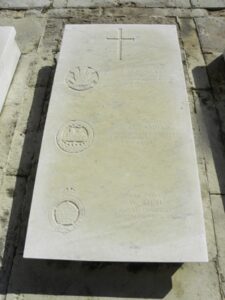
Walter Selwyn Orpen, Second Lieutenant, Lancashire Fusiliers. Walter was born on 20 July 1893, the Youngest son of Reverend Thomas Herbert Orpen and Mrs. Amy Octavia Gwyther Orpen, the sister of Lady Philipps of Picton Castle, of 5, Herschel Road, Cambridge. He was educated at Malvern, and at Selwyn College, Cambridge where he had completed his second year when war was declared. He was then in the OTC and was gazetted to the North Staffordshire Regiment in September 1914, before being posted to the 2nd Battalion, Lancashire Fusiliers. He was then posted to the 10th Battalion, which was attached to 52 Brigade, 17th (Northern) Division. Walter landed with the battalion at Boulogne on 15 July 1915. They spent their initial period of trench familiarisation and then holding the front lines in the southern area of the Ypres salient. Here they took part in fighting at the Bluff during February, 1916 before moving south, where they fought at the Battle of Albert, where the Division captured Fricourt at heavy cost during the opening of the Somme Offensive. Walter was killed here by a sniper on 6 July 1916. He was 22 years old, and is commemorated on the Thiepval Memorial, France. His Adjutant wrote; “During the time he has been with us I grew to like him more and more and to respect his many good qualities. He was always cheerful and brave.” Walter is also commemorated on the War Memorial at St. James Church, Abinger, the Cambridge (St. Giles) War Memorial, the Forest Green War Memorial, and the War Memorial in the Knoll School, Aspley Heath, Beds.
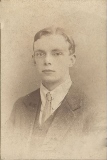
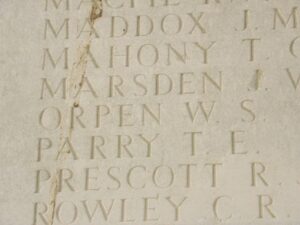
Alfred Ernest Howard Palmer, Private, TF/3065, Middlesex Regiment. Alfred was the son of Charles and Emily Eliza Palmer, of Prendergast, Haverfordwest. He had been educated at Haverfordwest Grammar School, and prior to the war resided at 66, Hampton Road, Forest Gate, Essex. Alfred enlisted at Stamford Brook, Middlesex on 13 November 1914 into the 2/10th Battalion, Middlesex Regiment. On 24 April 1915 the Battalion moved to 160 (Welsh Border) Brigade, 53rd (Welsh) Division, and on 18 July 1915 sailed from Devonport, and landed at Suvla Bay on 9 August 1915. The Division was almost immediately thrown into some desperate fighting over the ensuing weeks, in terrible conditions. Alfred contracted dysentery on Gallipoli, and was evacuated to Egypt for treatment, but died on 24 October 1915, aged 31. Alfred is buried in Port Said War Memorial Cemetery, Egypt.
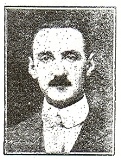
Harold Charles Phillips, Private, 4791, Australian Infantry. Harold was born in Haverfordwest in 1879, the son of Frederick and Mary Ann Phillips, and was the Brother of Reverend Arthur Gilbert Phillips, of Moravion Manse, Leominster. He had emigrated to Australia prior to the war, and lived at 75, Halifax Street, Adelaide, South Australia. Harold had originally enlisted into the 12th Battalion, AIF at Adelaide on 3 March 1916. He was discharged due to bad teeth, but as was the norm at the time, he must have had them all extracted, and he re-enlisted at Adelaide on 22 March 1916 and joined the 12th Reinforcements of the 27th Battalion, AIF, which was on the Western Front attached to the 7th Australian Brigade, 2nd Australian Division. This batch of reinforcements embarked at Adelaide aboard the H.M.A.T. Aenas on 11 April 1916. Harold worked his way up to Acting Sergeant during the voyage to England, but once there was charged with overstaying his leave, and for being in Salisbury without a pass. Still in England in 1917, Harold went absent without Leave and was caught by Military Police two months later. He was sentenced to 60 days detention, and was posted to the 7th Brigade Concert Party upon his release. Harold joined his unit on 30 October 1917 on the Western Front. They were in Flanders, after taking part in Third Ypres, where the Division fought at the Battles of the Menin Road, Polygon Wood, Broodseinde, Poelcapelle and Passchendaele. The 2nd Australian Division played a major role in the defence in Flanders during the German Offensive there in April 1918, and then during the Advance to Victory on the Somme, including the Capture of Hamel on 4 July 1918. They were at Hamel when Harold was killed in action on 9 July 1918. He was 39 years old, and is buried in Adelaide Cemetery, Villers Brettoneux, France.
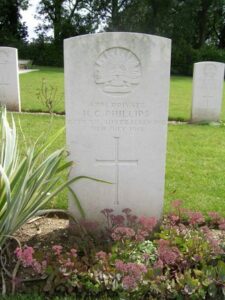
William Picton, Private, 34135, Welsh Regiment. William was the son of Charles and Elizabeth Picton, of 7, Cartlett, Haverfordwest. He enlisted at Briton Ferry into the 2nd Battalion, Welsh Regiment, which was attached to 3 Brigade, 1st Division. The Division had been one of the first to arrive in France, fighting at the Battle of Mons, and taking part in the retreat to the Marne, where the Germans were stopped. They then fought at the Aisne, and at Chivy, before being moved north to Ypres. Here they fought at the First Battle of Ypres, where they again stopped the German Offensive, before wintering in Flanders. The following year saw them in action again at the Battle of Aubers, before moving South to Loos, where they fought during the Battle of Loos, and the action at the Hohenzollern redoubt. William was killed during the initial assault, on 25 September 1915. He was only 17 years old, and is commemorated on the Loos Memorial, France. William is also commemorated on the Great Western Railway Memorial at Crewe.
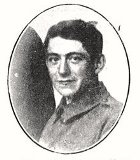
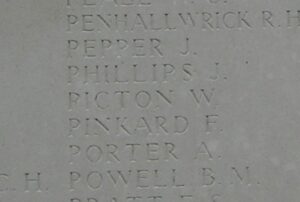
Edward Robertson, Private, 200765, Border Regiment. Eddie was the son of William Robertson, Inspector of Works in Haverfordwest, and Elizabeth Robertson, of 48, City Road, Haverfordwest. He had served an apprenticeship with Mr Saies of Market Street, and was a choir boy at St Mary’s Church. Eddie lived at Carlisle prior to enlisting at Kendal into the 1/4th Battalion, the Border Regiment on 14 September 1914. The Battalion was the Cumberland and Westmoreland Territorial Battalion, and was based at in Carlisle at the outbreak of war, attached to East Lancashire Division. It moved to Barro, then in September 1914 moved to Sittingbourne and transferred to Middlesex Brigade in Home Counties Division. On 29 September 1914 Eddie sailed with the Battalion from Southampton for India, where he remained for the duration of the war. Eddie died of fever in India on 28 April 1918, aged 23. He was buried in Jubbulpore Cantonment Cemetery, in India and is also commemorated on the Kirkee 1914-1918 Memorial.
Charles Allen Rogers, Private, 57225, Welsh Regiment. Charles was born in 1887, the son of Henry James Rogers and Sarah Ann Rogers (nee Davies), of Mariner’s Square, Haverfordwest. He married Rose Harries in 1910, and the couple resided at 18, Bush Row, Haverfordwest. Charles enlisted at Swansea into the 7th (Cyclist) Battalion, Welsh Regiment on 18 March 1915, and on 26 July 1916 landed in France, where he was posted to the 13th Battalion, Welsh Regiment which was attached to 114 Brigade, 38th (Welsh) Division. The Division had landed in France during December 1915 and had spent their first winter in the trenches near Armentieres. In June they marched south to the Somme, and famously captured Mametz Wood. Charles was part of a draft of reinforcements which helped rebuild the strength of the decimated battalion after it had been pulled from the Somme, and moved to Ypres to rebuild. Here they fought at the Battle of Pilckem Ridge, and the Battle of Langemarck, which is where Charles was killed in action on 21 August 1917, aged 30. He has no known grave, and so is commemorated on the Tyne Cot Memorial, Belgium.
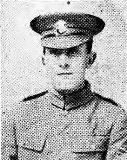
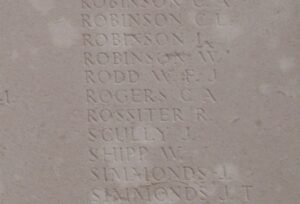
Arthur Llewellyn Thomas, Sapper, 43178, Royal Engineers. Arthur was the only son of William and Martha Thomas, of 26, Dew Street, Haverfordwest. He enlisted there into the Royal Engineers, and was posted to the 75th Field Company, which was attached to the Guards Division. This Division has the distinction of being formed in France in August 1915, from the various Guards units that had been with other Divisions. It remained on the Western Front throughout the war and saw its first major action during the Battle of Loos on 25 September 1915, remaining in the area during the coming months, where they also fought in the subsequent Action of Hohenzollern Redoubt. In July, 1916 the Division moved to the Somme, where they fought at the Battle of Flers-Courcelette, and then at the Battle of Morval, capturing Lesboeufs Village. They remained here for the winter, and in March, 1917 took part in the advance caused by the German Retreat to the Hindenburg Line. Later that year they moved north to Ypres, taking up positions north of Boesinghe, on the Yser Canal. Arthur was killed during a trench raid on 3 July 1917, aged 23. He is commemorated on the Ypres (Menin Gate) Memorial, Belgium.
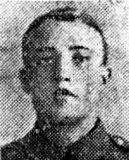
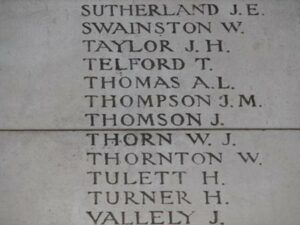
James Douglas Tombs, Second Lieutenant, Border Regiment. James was the second son of James Tombs, M.A., and Mary Sanderson Tombs, of Greenwood House, Fishguard, and the grandson of Prebendary Joseph Tombs, Rector of Burton, Pembs, and of the late Thomas Patterson of Rock Ferry. His father was Headmaster of Haverfordwest Grammar School. James was educated at Haverfordwest, and gained his B.A. at Keble College, Oxford, before gaining his commission into the 7th Battalion, Border Regiment. The Battalion was part of 51 Brigade, 17th Division, and landed in France in July 1915. It spent the first few months in France holding the line South of Ypres, and it was here that they had to withstand several German diversionary attacks, which were aimed at preventing the British reinforcing the besieged French Army at Verdun. James was wounded here, and brought to No. 2 General Hospital at St. Omer, where he sadly Died of Wounds on 18 February 1916, aged 25. He is buried in Longuenesse (St. Omer) Souvenir Cemetery. His elder brother Joseph Tombs also fell.
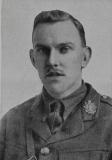
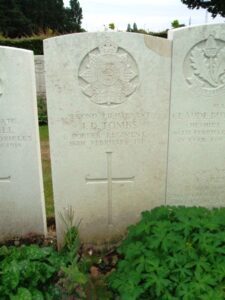
Joseph Simpson McKenzie Tombs, Second Lieutenant, Royal Field Artillery. Joseph was the brother of James, and the eldest son of James Tombs, M.A., and Mary Sanderson Tombs, of Greenwood House, Fishguard, and the grandson of Prebendary Joseph Tombs, Rector of Burton, Pembs, and of the late Thomas Patterson of Rock Ferry. He was educated at Haverfordwest and at Loretto, where he became a well regarded athlete, playing for the cricket XI and the rugby XV. He then worked at Hale and Patterson, Liverpool, where he began a career as a journalist, being a regular contributor to Punch. At the outbreak of war Joseph enlisted into the ranks of the Liverpool Scottish, but was quickly commissioned into the 148th Brigade, Royal Field Artillery, which was part of the 30th Division. The Division moved to Larkhill in September 1915, then to Belgium, with Joseph being seriously wounded almost as soon as he got to the Front. He Died of Wounds on 11 September 1915, aged 26, and is buried in Lijssenthoek Military Cemetery. His Commanding Officer wrote; ‘Universally popular with all ranks, very keen and very efficient, a man to be trusted at all times and in all places’. His younger brother James also fell.
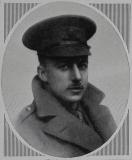
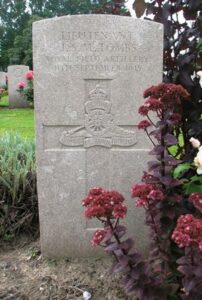
William White (aka Phelps), Private, 44061, Welsh Regiment. This man has proved very hard to identify, as the memorial shows him as William Phelps. William was born at Prendergast in 1894, the son of Elizabeth White. By 1899 Elizabeth had married Frank Phelps, and William was being raised by his Grandparents Titus and Hannah Thomas at Henry’s Moat. William was back living with Elizabeth at Prendergast by 1911, under the name William Phelps. He enlisted at Haverfordwest into the Welsh Regiment, and was posted to France early in 1916, joining the 2nd Battalion, Welsh Regiment, which was attached to 3 Brigade, 1st Division. He joined the battalion on the Somme, where it was preparing to take part in the Battle of Pozières. William survived the tough fighting south-east of Pozières, but was killed on 8 September 1916 near High Wood. He was 22 years old, and is buried in Caterpillar Valley Cemetery, Longueval, France.
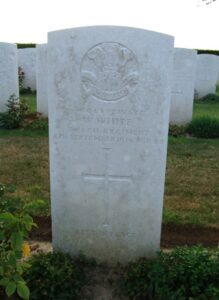
Douglas Jonathan Rogers Wilson, Second Lieutenant, Welsh Regiment. Douglas was born in 1893, the son of James and Constance Ann Wilson, of 36, High Street, Haverfordwest. He was commissioned into the Welsh Regiment, and was posted to the 9th Battalion, which was attached to 58 Brigade, 19th (Western) Division. The Division assembled around Bulford during September 1914. Divisional training was completed near Tidworth, from March 1915, and the Division crossed to France during July 1915, moving to positions near Loos. The Division fought during the opening attack of the Battle of Loos, which is where Douglas was killed on 25 September 1915, aged 22. He has no known grave, and so is commemorated on the Loos Memorial, France.
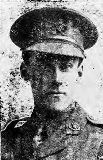
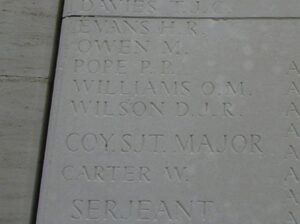
Lewis Wilson, Captain, Essex Regiment. Lewis was born at Begelley on 4 March 1884, the son of William Phillips Wilson and Margaret Elizabeth Wilson, of Langdon Farm, Begelley. He emigrated to Canada prior to the war. His next of kin was given as being his wife, Jessie Winifred Wilson (nee Forrester) who lived at Bank House, Milford Haven. Lewis enlisted at Valcartier, Canada on 23 September 1914 into the 7th Battalion, Canadian Infantry. He was immediately promoted to Corporal, as he has six years prior service with the Kashar Light Horse. Upon arriving in France in 1915, Lewis was commissioned into the Essex Regiment, and was posted to its 9th Battalion, where he served as Adjutant from 15 July 1916. Sadly Lewis took ill and was evacuated to a Military Hospital in London where he died at the 2nd London General Hospital on 27 November 1916, aged 32. He was buried in Kensal Green (All Souls) Cemetery, London. His brother William also fell.

William Clement Wilson, Lieutenant, Worcestershire Regiment. William was born on 16 February 1887, the son of William Phillips Wilson and Margaret Elizabeth Wilson, of Langdon Farm, Begelley. He was educated at Haverfordwest Grammar School. He gained his commission into the 1st Battalion, Worcestershire Regiment, which was in Cairo at the outbreak of war. It was swiftly recalled to Britain, and landed at Liverpool on 16 October 1914, where it joined 24 Brigade, 8th Division. The Battalion landed at Le Havre on 6 November 1914, and saw their first major action at the Battle of Neuve Chapelle, and then at the Battle of Aubers. They then saw further fighting at the Action of Bois Grenier. William was in charge of a Platoon of Grenadiers, which were sent in to support the assault on the German trenches on 25 September 1915. The Germans counter-attacked, and the last that was known of William is that he was caught up in a bomb blast. He is officially recorded as missing presumed killed here on 25 September 1915, aged 26. However a newspaper clipping of the time recorded that a German nurse had written to William’s parents, informing them that their son had been badly wounded and taken prisoner, and that he died in Hospital in Switzerland some time after. If true, then the official details of his death were never corrected, and so today, William is commemorated on the Ploegsteert Memorial, Belgium. His brother Lewis also fell.


Charles Rupert Woolcock, Private, 200131, Welsh Regiment. Charles was the son of James and Elizabeth Woolcock, of 2, Dark Street, Haverfordwest. He served with the 1/4th Battalion, Welsh Regiment, which had formed at Carmarthen during August, 1914 and had become attached to 159 Brigade, 53rd (Welsh) Division. The Division moved to the Mediterranean, sailing from Devonport in July 1915 arriving at Mudros by 5 August 1915. From here they moved to Gallipoli, landing on 9 August, where it was caught up in a desperate assault against the Turkish positions, and spent the next few days in isolated pockets, fighting against a Turkish counter-attack. The Division remained here throughout the coming months, and suffered severe losses in manpower strength during the great November 1915 blizzard on Gallipoli, when its total strength was reduced to less than that of a full-strength Brigade. On 11 December 1915 the Division was evacuated to Mudros, and by 23 December 1915 were moved to Egypt. They remained on the Suez Canal Defences for the next twelve months, and in early 1917 moved into Palestine, where they remained for the duration of the war, fighting at the Battles of Gaza, and successfully capturing Jerusalem. Charles was killed in action during the Third Battle of Gaza, on 4 November 1917. He was 21 years old, and is buried in Beersheba War Cemetery, Israel.


Charles Wren, Company Sergeant Major, 9242, Welsh Regiment. Charles was born at Tottenham. He married Lilian Mary Stephens at Haverfordwest in January 1913, probably whilst based at Llanion Barracks with the Welsh Regiment. Charles served with the 1st Battalion, Welsh Regiment. The Battalion was in India at the outbreak of war, and was recalled to Britain where it joined 84 Brigade, 28th Division. The Division formed in England between December 1914 and January 1915 from regular units returning from India, Singapore and Egypt. During January 1915 it moved to France, landing at Le Havre and moved to the Western Front, where it saw its first major action during the Second Battle of Ypres. Following serious casualties at Ypres, a Composite Brigade was formed, composing of the 2nd Battalion, the Buffs, 2nd Battalion, the Cheshire’s, 1st Battalion, the Welsh, and 1st Battalion, the York and Lancaster. Charles was one of the many casualties suffered at Second Ypres, on 24 April 1915, aged 26. He has no known grave, and so is commemorated on the Ypres (Menin Gate) Memorial, Belgium.
